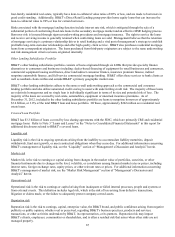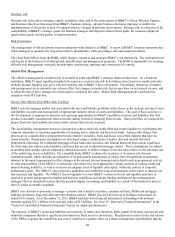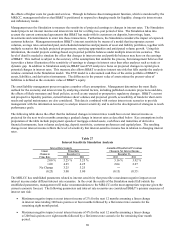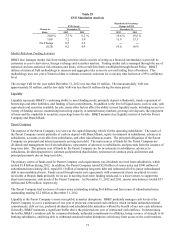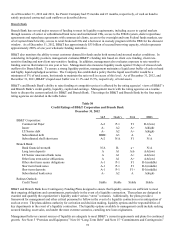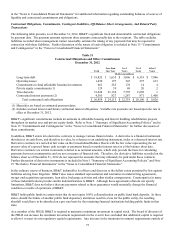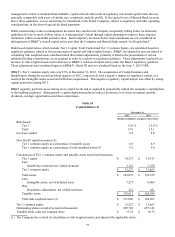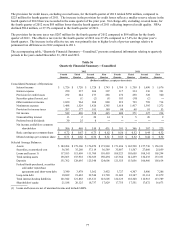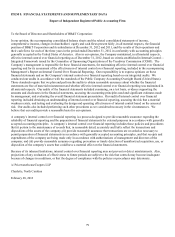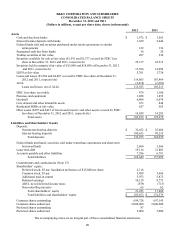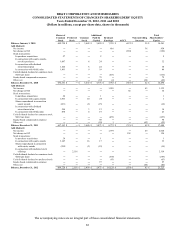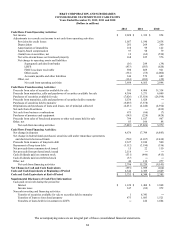BB&T 2012 Annual Report Download - page 96
Download and view the complete annual report
Please find page 96 of the 2012 BB&T annual report below. You can navigate through the pages in the report by either clicking on the pages listed below, or by using the keyword search tool below to find specific information within the annual report.
74
specified ranges requires the approval of the Federal Housing Finance Agency. Because the extent of any obligation to
increase BB&T’ s investment in the FHLB depends entirely upon the occurrence of a future event, potential future payments
to the FHLB are not determinable.
In the normal course of business, BB&T is also a party to financial instruments to meet the financing needs of clients and to
mitigate exposure to interest rate risk. Such financial instruments include commitments to extend credit and certain
contractual agreements, including standby letters of credit and financial guarantee arrangements. Further discussion of these
commitments is included in Note 15 “Commitments and Contingencies” in the “Notes to Consolidated Financial Statements.”
BB&T’ s significant commitments and obligations are summarized in the accompanying table. Not all of the commitments
presented in the table will be used, thus the actual cash requirements are likely to be significantly less than the amounts
reported.
Table 32
Summary of Significant Commitments
December 31, 2012
(Dollars in millions)
Lending commitments $ 43,760
Letters of credit and financial guarantees written 5,164
Total significant commitments $ 48,924
Related Party Transactions
The Company may extend credit to its officers and directors in the ordinary course of business. These loans are made under
substantially the same terms as comparable third-party lending arrangements and are in compliance with applicable banking
regulations.
Capital
The maintenance of appropriate levels of capital is a management priority and is monitored on a regular basis. BB&T’ s
principal goals related to the maintenance of capital are to provide adequate capital to support BB&T’ s risk profile consistent
with the Board-approved risk appetite, provide financial flexibility to support future growth and client needs, comply with
relevant laws, regulations, and supervisory guidance, achieve optimal credit ratings for BB&T and its subsidiaries and
provide a competitive return to shareholders.
Management regularly monitors the capital position of BB&T on both a consolidated and bank level basis. Capital ratios are
determined using operating forecasts and plans as well as stressed scenarios. In this regard, management’ s overriding policy
is to maintain capital at levels that are in excess of the operating capital guidelines, which are above the regulatory “well
capitalized” levels. Management has recently implemented stressed capital ratio minimum guidelines to evaluate whether
capital levels are sufficient to withstand the impact of plausible, severe economic downturns or bank-specific events. The
following table presents the minimum capital ratios:
Table 33
BB&T's Internal Capital Guidelines
Operating Stressed
Tier 1 Capital Ratio 9.5 % 7.5 %
Total Capital Ratio 11.5 9.5
Tier 1 Leverage Capital Ratio 6.5 5.0
Tangible Capital Ratio 5.5 4.0
Tier 1 Common Equity Ratio 8.0 6.0
Payments of cash dividends to BB&T’ s shareholders and repurchases of common shares are the methods used to manage any
excess capital generated. In addition, management closely monitors the Parent Company’ s double leverage ratio
(investments in subsidiaries as a percentage of shareholders’ equity) with the intention of maintaining the ratio below 125%.
The active management of the subsidiaries’ equity capital, as described above, is the process used to manage this important
driver of Parent Company liquidity and is a key element in the management of BB&T’ s capital position.
The capital of BB&T’ s subsidiaries is regularly monitored to determine if the levels that management believes are the most
beneficial and efficient for their operations are maintained. Management intends to maintain capital at Branch Bank at levels
that will result in these subsidiaries being classified as “well-capitalized” for regulatory purposes. Secondarily, it is





